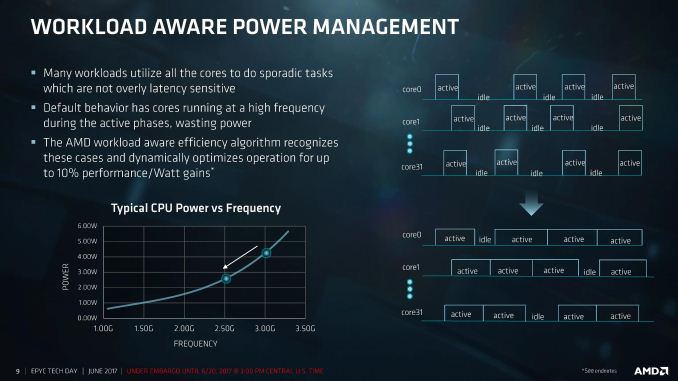AMD's Future in Servers: New 7000-Series CPUs Launched and EPYC Analysis
by Ian Cutress on June 20, 2017 4:00 PM EST- Posted in
- CPUs
- AMD
- Enterprise CPUs
- EPYC
- Whitehaven
- 1P
- 2P
Power
As with the Ryzen parts, EPYC will support 0.25x multipliers for P-state jumps of 25 MHz. With sufficient cooling, different workloads will be able to move between the base frequency and the maximum boost frequency in these jumps – AMD states that by offering smaller jumps it allows for smoother transitions rather than locking PLLs to move straight up and down, providing a more predictable performance implementation. This links into AMD’s new strategy of performance determinism vs power determinism.
Each of the EPYC CPUs include two new modes, one based on power and one based on performance. When a system configured at boot time to a specific maximum power, performance may vary based on the environment but the power is ultimately limited at the high end. For performance, the frequency is guaranteed, but not the power. This enables AMD customers to plan in advance without worrying about how different processors perform with regards voltage/frequency/leakage, or helps provide deterministic performance in all environments. This is done at the system level at boot time, so all VMs/containers on a system will be affected by this.
This extends into selectable power limits. For EPYC, AMD is offering the ability to run processors at a lower or higher TDP than out of the box – most users are likely familiar with Intel’s cTDP Up and cTDP Down modes on the mobile processors, and this feature by AMD is somewhat similar. As a result, the TDP limits given at the start of this piece can go down 15W or up 20W:
| EPYC TDP Modes | ||
| Low TDP | Regular TDP | High TDP |
| 155W | 180W | 200W |
| 140W | 155W | 175W |
| 105W | 120W | - |
The sole 120W processor at this point is the 8-core EPYC 7251 which is geared towards memory limited workloads that pay licenses per core, hence why it does not get a higher power band to work towards.
Workload-Aware Power Management
One of AMD’s points about the sort of workloads that might be run on EPYC is that sporadic tasks are sometimes hard to judge, or are not latency sensitive. In a non-latency sensitive environment, in order to conserve power, the CPU could spread the workload out across more cores at a lower frequency. We’ve seen this sort of policy before on Intel’s Skylake and up processors, going so far as duty cycling at the efficiency point to conserve power, or in the mobile space. AMD is bringing this to the EPYC line as well.
Rather than staying at the high frequency and continually powering up and down, by reducing the frequency such the cores are active longer, latency is traded for power efficiency. AMD is claiming up to a 10% perf-per-Watt improvement with this feature.
Frequency and voltage can be adjusted for each core independently, helping drive this feature. The silicon implements per-core linear regulators that work with the onboard sensor control to adjust the AVFS for the workload and the environment. We are told that this helps reduce the variability from core-to-core and chip-to-chip, with regulation supported with 2mV accuracy. We’ve seen some of this in Carrizo and Bristol Ridge already, although we are told that the goal for per-core VDO was always meant to be EPYC.
This can not only happen on the core, but also on the Infinity Fabric links between the CPU dies or between the sockets. By modulating the link width and analyzing traffic patterns, AMD claims another 8% perf-per-Watt for socket-to-socket communications.
Performance-Per-Watt Claims
For the EPYC system, AMD is claiming power efficiency results in terms of SPEC, compiled on GCC 6.2:
| AMD Claims 2P EPYC 7601 vs 2P E5-2699A V4 |
||
| SPECint | SPECfp | |
| Performance | 1.47x | 1.75x |
| Average Power | 0.96x | 0.99x |
| Total System Level Energy | 0.88x | 0.78x |
| Overall Perf/Watt | 1.54x | 1.76x |
Comparing a 2P high-end EPYC 7601 server against Intel’s current best 2P E5-2699A v4 arrangement, AMD is claiming a 1.54x perf/watt for integer performance and 1.76x perf/watt on floating point performance, giving more performance for a lower average power resulting in overall power gains. Again, we cannot confirm these numbers, so we look forward to testing.












131 Comments
View All Comments
Gothmoth - Tuesday, June 20, 2017 - link
but where is room for the ryzen cpus then? when a 16 core server CPU cost only 899$ and TR is significantly cheaper. and if im not wrong there is at least a 12 core TR model too.Bateluer - Tuesday, June 20, 2017 - link
Plenty of room between $470 and $900 for Threadripper parts, and plenty of room below $470 for us regular joes who can't afford dropping a grand on just the CPU.Gothmoth - Tuesday, June 20, 2017 - link
"significantly lower".and the cheapest epyc server is already a lot less than 900$ ... when we look at the information above.
Zingam - Wednesday, June 21, 2017 - link
I'm pretty sure MoBos will be more expensive without consumer features and especially no "Gaming" on the cardbox and no RGB lighting.Jimster480 - Monday, June 26, 2017 - link
I agree but there is alot of room even between $200 and $50 for CPU's lol.Most people don't need an 1800x, nevermind anything above that.
The average person only needs 4 cores, and most gamers will do fine with a 6C ryzen or the entry level 8C.
sharath.naik - Monday, July 3, 2017 - link
From my experience even highly threaded application get bottlenecked due to max single core performance, as the code path will have a single thread part in between the multithread path which becomes a huge bottle neck in these high core count cpus. Intel has a huge advantage here in terms of max turbo for the newer xeons all reaching 4.2 Ghz. But the 1p 32 core for 2000$ right away makes the v4 Xeons obsolete in terms of price to performance.jjj - Tuesday, June 20, 2017 - link
Dual socket SKUs 32-core CPUs starting at $3400, 24-core from $1850, 16-core from $650, 8-core from $475for single socket the 32 cores at 2100$, 24 cores 1075$, 16 cores 750$.
Server margins are high so no reason for AMD to aim higher that that but they could be more aggressive in consumer.
rahvin - Wednesday, June 21, 2017 - link
All they need to be is cheaper per watt than intel for the same or better performance and they'll have massive sales to the cloud companies not even including taking any of the SB market. In other words they don't need to be half the price of Intel. But the hope is that Intel will lower prices on Xeon's and AMD will be forced to lower prices some more.Frankly server part pricing is atrocious right now, a little competition from AMD could drive server part pricing down to something reasonable like the last time AMD competed with Opteron.
IanHagen - Tuesday, June 20, 2017 - link
I'm really excited with Epyc. I remember Interlagos being released with performance well bellow existing Intel's offerings and now look at this! I can't wait for concrete benchmarks.DanNeely - Tuesday, June 20, 2017 - link
"Each CPU will support 128 PCIe 3.0 lanes, suitable for six GPUs with full bandwidth support (plus IO) or up to 32 NVMe drives for storage. " Shouldn't this be 8 GPUs or 32 NVMe drives? (Or 7/31 if a Southbridge is connected and eats 4 of the lanes.)